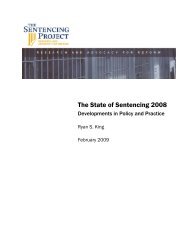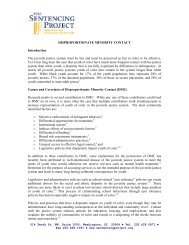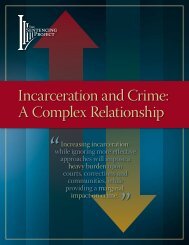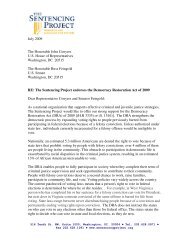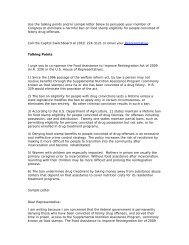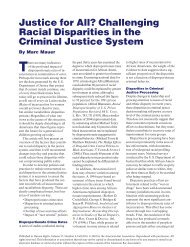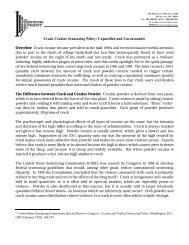VIEW PDF - The Sentencing Project
VIEW PDF - The Sentencing Project
VIEW PDF - The Sentencing Project
Create successful ePaper yourself
Turn your PDF publications into a flip-book with our unique Google optimized e-Paper software.
<strong>The</strong> National Juvenile Justice and Delinquency Prevention Coalition (NJJDPC) brings together a<br />
collaborative array of youth‐ and family‐ serving, social justice, law enforcement, corrections,<br />
and faith‐based organizations, that work to ensure healthy families, build strong communities<br />
and improve public safety by promoting fair and effective policies, practices and programs for<br />
youth involved or at risk of becoming involved in the juvenile and criminal justice systems.<br />
NJJDPC achieves its mission by engaging a broad spectrum of opinion leaders and<br />
stakeholders, including the voices of those most affected by the juvenile justice system, to:<br />
• advocate for sensible and safe solutions to crime and delinquency;<br />
• build and leverage policy leadership in the field; and<br />
• serve as a clearinghouse for research and best practices within our nation’s juvenile<br />
and criminal justice systems.<br />
For more information, please contact the Coalition Co‐Chairs:<br />
Ashley Nellis, <strong>The</strong> <strong>Sentencing</strong> <strong>Project</strong><br />
202‐628‐0871 or anellis@sentencingproject.org<br />
Tara Andrews, Coalition for Juvenile Justice<br />
202‐467‐0864 or andrews@juvjustice.org<br />
February 15, 2011
T<br />
he juvenile justice system in the United States is in urgent need of reform<br />
and federal leadership is necessary. Despite a steady drop in juvenile<br />
detention over the past decade, there are still far too many young people<br />
securely detained for first‐time, nonviolent offenses that would not be illegal if<br />
committed by an adult (i.e., status offenses such as truancy). Nationwide each year,<br />
police make 2.1 million juvenile arrests; 1 1.7 million cases are referred to juvenile<br />
courts; 2 and over 200,000 youth are prosecuted in the adult criminal justice<br />
system. 3 On any given night, approximately 81,000 youth are confined in juvenile<br />
facilities, 4 and 10,000 children are held in adult jails and prisons. 5 Incarcerated<br />
youth are particularly vulnerable to victimization and abuse by peers, older<br />
inmates, and staff. 6 Also, the United States is alone in imposing the sentence of life<br />
without parole for crimes committed when under the age of 18. Recent estimates<br />
find that 2,589 people are currently serving a juvenile life without parole sentence<br />
for a crime committed as a juvenile. 7<br />
Current juvenile justice practices often ignore children's amenability to<br />
rehabilitation, cause long‐term collateral consequences, waste taxpayer dollars,<br />
and violate our deepest held principles about equal justice under the law and the<br />
role of the juvenile justice system. Our system demonstrates racial and ethnic<br />
disparities, lacks sound mental health and drug treatment services, and applies<br />
excessively harsh sanctions for minor and nonviolent adolescent misbehavior.<br />
With strong federal leadership, reforms are possible. Research over the past 20<br />
years has increased our understanding of what works, and how to best approach<br />
juvenile delinquency and system reform. Promising reforms are being<br />
implemented in many jurisdictions across the country, and there is an increasingly<br />
clear path for moving toward evidence‐based approaches to reducing adolescent<br />
crime. <strong>The</strong> Obama Administration has the opportunity to restore an effective<br />
system of juvenile justice for our youth and should begin by focusing on the<br />
following five priority areas:<br />
1) Restore Federal Leadership in Juvenile Justice Policy<br />
2) Support Prevention, Early Intervention, and Diversion Strategies<br />
3) Keep Court‐Involved Youth Safe<br />
4) Remove Youth from the Adult Criminal Justice System<br />
5) Support Youth Reentry<br />
1
I. Restore Federal Leadership in Juvenile Justice Policy<br />
Over the past decade, the Office of Juvenile Justice and Delinquency Prevention<br />
(OJJDP) suffered a drastic depletion of funding and support, and the agency’s<br />
commitment to the most important issues confronting youth has steadily waned. 8<br />
Funding levels for OJJDP have declined 90 percent since 2002. In addition, the<br />
Juvenile Justice and Delinquency Prevention Act (JJDPA) is four years’ overdue for<br />
reauthorization. <strong>The</strong> Administration must provide the clear direction and resources<br />
needed to help States create and sustain juvenile systems that cost less, enhance<br />
public safety and treat court‐involved youth in fair, humane and effective ways.<br />
Recommendations for the Obama Administration<br />
Appoint an Administrator for OJJDP<br />
<strong>The</strong> Office of Juvenile Justice and Delinquency Prevention is the sole agency within<br />
the U.S. Department of Justice without a permanent Administrator. This has halted<br />
progress in advancing reforms, reauthorizing the JJDPA, and sends a message that<br />
federal leadership in juvenile justice is not a priority. <strong>The</strong> Administration must act<br />
quickly to appoint an experienced and competent OJJDP Administrator.<br />
Restore and Increase Funding for Evidence‐Based Reforms<br />
As a national leader with access to and command of national resources, OJJDP is<br />
well positioned to focus on identifying, developing and promoting what works to<br />
reduce delinquency and to advance youth, family and community success. OJJDP<br />
should continue to evaluate the evidence base for other promising programs,<br />
support increased research to find new evidence‐based programs that work, and<br />
discontinue federal funding for programs that are ineffective, such as boot camps<br />
and Scared Straight programs. We applaud the decision to update the Model<br />
Programs Guide in the OJJDP 2011 Program Plan. However, the Administration<br />
must request and advocate for sufficient appropriations for OJJDP and the juvenile<br />
justice programs it administers. <strong>The</strong> President’s budget should restore juvenile<br />
justice funding to its FY 2002 levels, adjusted for inflation, and increase these<br />
investments over the next five years.<br />
Strengthen Federal/State Partnerships<br />
<strong>The</strong> partnerships between States and OJJDP should be strengthened by expanding<br />
training, technical assistance, research, and evaluation. Further, there should be<br />
greater transparency and accountability by making State plans and reports on<br />
compliance with the core protections publicly available on the OJJDP website. <strong>The</strong><br />
OJJDP Administrator should be required to investigate and make a public report<br />
available when a State is out of compliance with any of the core protections.<br />
2
Ensure Program Policies and Practices Involve Families<br />
Consistent with the guiding principle to “empower communities and engage youth<br />
and families” because “their strengths, experiences, and aspirations provide an<br />
important perspective in developing solutions” in the 2011 Program Plan, OJJDP<br />
should have an intentional focus on increasing family and youth involvement in all<br />
program planning and grant making activities. At a minimum, OJJDP should conduct<br />
focus groups to hear the concerns of families, provide online resources for families<br />
to better understand and navigate the justice system, and fund parent resource,<br />
support, and training centers to provide direct services to families of youth involved<br />
in the justice system.<br />
Improve Data Collection<br />
Race, Ethnicity and Gender<br />
We applaud OJJDP for recognizing the importance of research, evaluation, and data<br />
collection in the 2011 Program Plan. However, more improvements for data<br />
collection at the State and local level are still needed. First, few States and localities<br />
are able to achieve meaningful changes in their juvenile justice systems without<br />
adequate data, particularly data disaggregated by race, ethnicity, and gender so<br />
communities are able to develop culturally and linguistically appropriate services<br />
for youth and their families. OJJDP should prioritize this level of data collection<br />
through policy guidance, resource allocation, and training.<br />
Transfer to the Adult System<br />
Even the most cursory data on youth prosecuted in the adult criminal justice<br />
system via judicial, statutory, or prosecutorial waiver mechanisms and age of<br />
jurisdiction laws are not currently collected or reported, despite the widespread<br />
use of transfer to the adult system. <strong>The</strong> Administration has made progress on<br />
collecting this information at the federal level by recently funding the Survey of<br />
Juveniles Charged in Criminal Courts through the Bureau of Justice Statistics. <strong>The</strong><br />
Administration should require states to track the frequency with which juveniles<br />
are transferred to the adult system and evaluate the impact of prosecuting youth as<br />
adults. In addition, the 2011 OJJDP Program Plan should be modified to ensure that<br />
youth processed in the adult system are included in the scope of funded research.<br />
School Discipline<br />
<strong>The</strong>re must be better data collection on the consequences of school discipline (i.e.,<br />
suspensions, expulsions, corporal punishment, referrals to disciplinary alternative<br />
schools and court referrals). <strong>The</strong> Administration should require that measures of<br />
school discipline be used in assessments of school success as part of the Elementary<br />
and Secondary Education Act. Signs of poor school climate, high disciplinary rates<br />
3
and subgroup disparities should trigger required assistance and support from local,<br />
State and federal educational agencies.<br />
Strengthen the Powers of the Federal Coordinating Council on JJDP<br />
<strong>The</strong> Federal Coordinating Council on Juvenile Justice and Delinquency Prevention<br />
plays an important role in ensuring that all federal agencies effectively serve youth<br />
at risk of entering the system, youth in the system, and youth transitioning back to<br />
their community. As members of this council, the agency directors should<br />
personally attend these meetings to assess the effectiveness of current<br />
programming and determine where systems and agency practices can be improved.<br />
<strong>The</strong> council should hold regular “listening sessions” to hear directly from current or<br />
formerly court‐involved youth, their families and advocates. Further, the council<br />
should be expanded by two new members to include family and youth<br />
representatives.<br />
II.<br />
Support Prevention, Early Intervention, and Diversion<br />
Strategies<br />
Decades of empirical studies of juvenile crime by scholars in the fields of<br />
criminology, child psychology, mental health, substance abuse, economics, and<br />
public health reveal that public dollars spent on effective prevention and early<br />
intervention programs targeting at‐risk youth are very effective at reducing<br />
delinquency. Research also shows that broadening prosecutorial powers and<br />
stiffening criminal penalties for young people do not work to lower crime or<br />
prevent reoffending. 9 Similarly, public opinion polls reveal that taxpayers<br />
overwhelmingly favor paying for prevention, education, and rehabilitation<br />
programs over prosecution and incarceration of juveniles who are adjudicated<br />
delinquent. 10<br />
While we are encouraged that the Obama Administration and the Attorney General<br />
have identified children’s exposure to violence, gang violence, and community<br />
violence as focus areas for the Department of Justice, below are additional<br />
recommendations to prevent crime and keep youth out of the system.<br />
Recommendations for the Obama Administration<br />
Continue to Support Community‐Based Alternatives to Detention<br />
OJJDP has a vital role to play in helping States and localities prevent and reduce the<br />
use of out of home placements. OJJDP has begun to partner with the Annie E.<br />
Casey Foundation to replicate the Juvenile Detention Alternatives Initiative (JDAI),<br />
which is aimed at reducing pre‐adjudication detention through a variety of tools<br />
and principles, such as objective risk assessment tools. We support the<br />
4
continuation of efforts to reduce the use of incarceration and other residential<br />
facilities.<br />
Improve School Safety and Reduce Harsh Disciplinary Practices<br />
Academic success plays a critical role in preventing delinquent behavior and<br />
promoting positive outcomes for youth and safer communities. Youth who drop out<br />
or are pushed out of school find themselves with fewer opportunities for gainful<br />
employment and are more likely than youth who remain in school to commit<br />
delinquent acts. In 2006‐2007, nearly 10% of young male high school dropouts<br />
were institutionalized on a given day compared to only 3% of high school graduates<br />
and less than .1% of college graduates. 11 In addition, out‐of‐school suspension and<br />
expulsion are being overused and disproportionately affect youth of color, students<br />
with disabilities, and LGBT youth. According to the Dignity in Schools campaign,<br />
each year more than three million students are suspended and over 100,000 are<br />
expelled nationally. 12 African‐American students (nearly 3 times as likely to be<br />
suspended and 3.5 times as likely to be expelled as white students) and Latino<br />
students (1.5 times as likely to be suspended and twice as likely to be expelled as<br />
white students) bear a disproportionate burden of these punishments when<br />
compared to their white peers. 13 Students with disabilities also experience<br />
disciplinary removal from the classroom at rates that are disproportionate to their<br />
overall representation in the K‐12 population. 14 A recent study indicates that nonheterosexual<br />
youth are expelled at disproportionate rates. 15<br />
<strong>The</strong> Administration should help schools improve school safety and keep the<br />
maximum number of students in their regular educational placements by providing<br />
training and technical assistance to schools on how to use alternatives to<br />
suspension and expulsion, family and tutoring supports, social and emotional<br />
learning, positive youth development programming, bullying prevention, threat<br />
assessment, positive behavior supports, and restorative justice practices.<br />
Examine the Role and Impact of Mental Health and Substance Abuse Disorders<br />
We are encouraged that OJJDP proposed to fund an initiative in partnership with<br />
the Department of Health and Human Services to identify best practices for juvenile<br />
drug courts and adolescent treatment. As an extension of that initiative, OJJDP, in<br />
coordination with the Substance Abuse and Mental Health Services Administration,<br />
should conduct a major study regarding the prevalence of mental health and<br />
substance abuse disorders among juvenile justice populations served by all U.S.<br />
States and territories. According to recent data released by OJJDP, 44 percent of<br />
youth in custody say they were under the influence of alcohol or drugs during the<br />
commission of their offense. 16 Additionally, OJJDP should increase training and<br />
technical assistance related to mental health and substance abuse, including best<br />
practices for law enforcement and probation officers, detention/corrections and<br />
community corrections personnel, court services personnel and others.<br />
5
Promote Lesbian, Gay, Bisexual, and Transgender (LGBT) Cultural Competence<br />
Recent research shows that up to 13 percent of youth in juvenile detention identify<br />
as LGBT. 17 In their homes, schools, and communities, LGBT youth face challenges<br />
related to their sexual orientation and/or gender identity that can increase their<br />
risk of coming into contact with the juvenile justice system. A recent study in<br />
Pediatrics found that adolescents who self‐identified as LGB were about 50 percent<br />
more likely to be stopped by the police than other teenagers. In particular, girls<br />
who identified themselves as lesbian or bisexual reported about twice as many<br />
arrests and convictions as other girls who had engaged in similar behavior. 18 LGBT<br />
youth also experience high rates of school violence, interfering with their ability to<br />
learn and impacting their involvement with the juvenile courts.<br />
<strong>The</strong> Administration should promote LGBT cultural competence in Safe<br />
Schools/Healthy Students (SS/HS), a program widely recognized as a model for<br />
achieving effective collaboration across public education, local mental health, and<br />
juvenile justice. SS/HS evaluations should reflect efforts to meet the needs of LGBT<br />
students, including decreasing the rate of arrest and referral to the juvenile court of<br />
LGBT youth.<br />
III.<br />
Keep Court‐Involved Youth Safe<br />
Far too often, incarcerated youth endure abusive conditions. In a recent study by<br />
the Bureau of Justice Statistics (BJS), a shocking one in eight youth in juvenile<br />
facilities reported experiencing sexual abuse at their current facility in the past year<br />
alone, with more than one in five non‐heterosexual youth reporting such abuse. 19<br />
An earlier BJS survey, which focused solely on sexual violence reports filed with<br />
prison officials, confirmed that young inmates are also more likely to be victimized<br />
when in adult facilities. 20 Reports of widespread abuses in juvenile institutions in<br />
California, 21 Indiana, 22 Mississippi, 23 Ohio, 24 Texas, 25 and other states demonstrate<br />
the importance of using federal laws to ensure the safety of children in custody.<br />
Abuses have included frequent use of pepper spray, sexual assaults by staff, hogtying,<br />
and subjecting youth to excessive restraint and isolation. Youth who commit<br />
crimes must be held accountable, but no court disposition, regardless of the<br />
offense, should ever include abuse, mental health deterioration, or death in a<br />
juvenile facility, adult jail or prison.<br />
OJJDP has begun to recognize the national role it should play in ensuring that<br />
incarcerated youth are held in safe conditions by initiating a new Center on Youth<br />
in Custody. We also support the new Protection and Advocacy Juvenile Justice<br />
Monitoring <strong>Project</strong> proposed in the 2011 Program Plan and other efforts to<br />
encourage states to establish community advisory boards or other independent<br />
monitoring structures to monitor and improve conditions of confinement.<br />
6
Recommendations for the Obama Administration<br />
Build a Comprehensive Center on Youth in Custody<br />
We support the development of a comprehensive Center on Youth in Custody that<br />
provides training and technical assistance to all facilities that currently incarcerate<br />
youth including juvenile detention and correctional facilities, as well as adult jails<br />
and prisons. We hope this new entity will make best practices and standards<br />
available nationwide and help states to provide necessary training for facility staff<br />
and to adopt best practices in programming, behavior management, and security<br />
while eliminating dangerous practices and unnecessary isolation. In addition, we<br />
recommend that this new entity have an advisory board that includes youth and<br />
family voices.<br />
Enact and Enforce National Standards Protecting Youth from Sexual Abuse<br />
In accordance with the Prison Rape Elimination Act of 2003 (PREA), the Attorney<br />
General was to ratify binding national standards addressing sexual abuse in<br />
detention within one year from receiving recommended standards from the<br />
bipartisan National Prison Rape Elimination Commission (NPREC). <strong>The</strong> commission<br />
released its recommended standards in June 2009, proposed rules were submitted<br />
for comment on February 3, 2011, but the Attorney General has yet to finalize<br />
regulations to implement PREA. <strong>The</strong> standards enacted by the Attorney General<br />
should ensure that:<br />
• Responsible, professional adults trained in adolescent behavior and<br />
development, provide continuous, direct supervision of youth and should not<br />
rely on video surveillance.<br />
• <strong>The</strong> Adult and Lockup Standards prohibit holding youth in adult facilities to<br />
protect youth from sexual abuse and dangers associated with isolation.<br />
• <strong>The</strong> standards underscore the need to protect youth from harmful cross‐gender<br />
interactions and recognize that a large percentage of sexual abuse of young<br />
people in facilities is perpetrated by staff members of the opposite sex. <strong>The</strong><br />
standards also should prohibit one‐on‐one cross‐gender supervision and<br />
provide additional guidance on how these prohibitions apply to transgender<br />
residents.<br />
• <strong>The</strong> standards provide more specific guidance on how to use individual safety<br />
plans to keep vulnerable youth safe and avoid resorting to blanket policies for<br />
certain groups, such as lesbian, gay, bisexual, or transgender (LGBT) youth.<br />
• <strong>The</strong> Juvenile Standards do not treat voluntary consensual sexual activity as<br />
sexual abuse, even if facilities prohibit voluntary consensual sexual activity<br />
among residents by rule. Conflating abuse and voluntary consensual sexual<br />
activity often leads to overly harsh responses that misuse limited resources and<br />
7
have a disproportionately negative impact on certain groups, such as LGBT<br />
youth.<br />
• <strong>The</strong> Juvenile Standards include a clear statement of the dangers associated with<br />
isolation in order to reinforce a facility’s responsibility to keep children safe<br />
without resorting to that practice. Additionally, youth who engage in sexual<br />
abuse should not be subjected to prolonged disciplinary isolation as punishment<br />
for that behavior.<br />
• Employees, volunteers, and contractors working in all facilities that house youth<br />
receive training on adolescent development, the prevalence of trauma and<br />
abuse, mandatory reporting requirements, and the agency’s zero tolerance<br />
policy on sexual abuse of incarcerated persons.<br />
• <strong>The</strong> standards preserve the caretaking relationship medical and mental health<br />
professionals have with youth by eliminating inquiries into prior offending<br />
behavior and obtaining informed consent before sharing sensitive information.<br />
• Medical and mental health programs engage in quality assurance activities,<br />
including monitoring with the standards.<br />
• <strong>The</strong> standards ensure access to prophylactic HIV treatment and emergency<br />
contraception and pregnancy‐related services.<br />
• Limited English Proficient (LEP) children not only understand sexual misconduct<br />
policies and reporting procedures, but are also able to communicate with staff<br />
during other important phases, including investigation, medical and mental<br />
health care, and other supportive services.<br />
• <strong>The</strong> standards require agencies to only hire, retain, and promote staff members<br />
who are qualified by experience, education, and background to protect children<br />
by considering information from civil protection orders and annual criminal<br />
background checks.<br />
<strong>The</strong> Attorney General should move quickly to ratify the standards after addressing<br />
the unique concerns and development needs of youth in juvenile and adult<br />
facilities. Once these standards are enacted, the Department of Justice must<br />
ensure that agencies comply with them, including providing the needed training<br />
and technical assistance.<br />
Encourage States to Keep Youth off Public Sex Offender Registries<br />
In the absence of Congressional action on SORNA, the Attorney General should<br />
refrain from promulgating policies or promoting practices that unnecessarily<br />
stigmatize youth. <strong>The</strong> Attorney General should maintain a policy that allows states<br />
to exercise discretion to establish or maintain a separate juvenile registry that is<br />
accessible to the relevant authorities but not the general public, and allow for the<br />
courts or designated agency to determine whether community notification is<br />
required.<br />
8
IV.<br />
Remove Youth from the Adult Criminal Justice System<br />
<strong>The</strong> Administration and OJJDP have not placed enough emphasis on addressing the<br />
needs of youth in the adult criminal justice system. Across the United States, an<br />
estimated 200,000 youth are tried, sentenced, or incarcerated in the adult criminal<br />
justice system every year. 26 Trying youth as adults is bad for public safety and for<br />
youth. Youth incarcerated in the adult system are more likely to reoffend than<br />
similarly situated youth who are retained in the juvenile system, and these offenses<br />
tend to be more violent. According to the federal Centers for Disease Control and<br />
Prevention, youth who are transferred from the juvenile court system to the adult<br />
criminal system are approximately 34% more likely than youth retained in the<br />
juvenile court system to be re‐arrested for violent or other crime. 27<br />
Youth in the adult system are also at great risk of sexual abuse and suicide when<br />
housed in adult jails and prisons. <strong>The</strong> National Prison Rape Elimination Commission<br />
found that “more than any other group of incarcerated persons, youth incarcerated<br />
with adults are probably at the highest risk for sexual abuse.” 28 Youth are also<br />
often placed in isolation, locked down 23 hours a day in small cells with no natural<br />
light, and these conditions cause anxiety, paranoia, and exacerbate existing mental<br />
disorders and heighten the risk of suicide. In fact, youth housed in adult jails are 36<br />
times more likely to commit suicide than are youth housed in juvenile detention<br />
facilities. 29<br />
<strong>The</strong> majorities of youth tried in the adult system are charged with non‐violent<br />
offenses, 30 and yet still suffer the lifelong consequences from an adult criminal<br />
conviction. Youth are often denied employment and educational opportunities 31<br />
which makes their transitions to adulthood difficult. If sentenced to an adult prison,<br />
approximately 80 percent of youth convicted as adults will be released from prison<br />
before their 21st birthdays, and 95 percent will be released before their 25th<br />
birthdays. 32 Many of these youth will not have been provided with the education<br />
and services they need to make a successful transition to productive adulthood.<br />
<strong>The</strong> Administration should provide strong leadership for states to reduce and<br />
eventually eliminate their harmful and dangerous reliance on trying youth as adults.<br />
Recommendations for the Obama Administration<br />
Fully Protect Youth in Adult Facilities from Sexual Abuse<br />
In accordance with the Prison Rape Elimination Act of 2003 (PREA), the Attorney<br />
General should enact standards to protect youth from sexual abuse. In light of the<br />
overwhelming evidence that youth cannot be kept safe in adult facilities and the<br />
research demonstrating that keeping youth in adult facilities is harmful to the youth<br />
and to public safety, the PREA standards should be modified to require removal of<br />
youth from adult jails and prisons altogether. This change would be consistent with<br />
9
existing laws and policies used by the Federal Bureau of Prisons that prohibit the<br />
placement of youth in federal custody in adult jails and prisons.<br />
Help States Remove Youth from Adult Facilities<br />
Roughly 1 in 4 incarcerated youth are held in adult jails or prisons instead of<br />
juvenile facilities. Several jurisdictions including Virginia, Colorado, and Multnomah<br />
County, Oregon have recently changed their state laws to allow youth tried in the<br />
adult system to be housed in juvenile facilities. OJJDP should fund a demonstration<br />
program to help these and other jurisdictions remove youth from adult jails and<br />
prisons.<br />
V. Support Youth Reentry<br />
Approximately 100,000 young people under age 18 leave secure juvenile facilities<br />
and return to their communities each year. 33 Youth are often discharged from care<br />
back to families struggling with domestic violence, drug and alcohol abuse, and<br />
unresolved mental health disabilities. Many youth are placed back into<br />
neighborhoods with few youth supportive programs, high crime rates, poverty, and<br />
poorly performing schools. Public safety is compromised when youth leaving outof‐home<br />
placement are not afforded necessary supportive services upon reentering<br />
their communities, increasing the likelihood of recidivism.<br />
Reentry services and aftercare for youth exiting juvenile justice facilities reduce<br />
recidivism and support their successful reintegration back into families and<br />
communities. By fostering improved family relationships and functioning,<br />
reintegration into school, and mastery of independent life skills, reentry services<br />
help youth build resiliency and positive development to divert them from harm and<br />
delinquent behaviors. If our nation expects to reduce recidivism, it must establish a<br />
national policy agenda which supports reentry services to connect youth with<br />
meaningful opportunities for self‐sufficiency and community integration. Policy<br />
and practice must be grounded in evidence‐based practices and involve<br />
cooperation among existing federal and state agencies, local stakeholders, juvenile<br />
justice experts, and reform advocates.<br />
We are encouraged that the 2011 OJJDP Program Plan does include additional<br />
funding for demonstration projects under the Second Chance Act Youth Offender<br />
Reentry Initiative and an evaluation of the Second Chance Act Juvenile Mentoring<br />
Initiative. Below are additional recommendations to help youth return safely to<br />
their communities.<br />
10
Recommendations for the Obama Administration<br />
Increase Federal Coordination on Youth Reentry<br />
<strong>The</strong> Attorney General should oversee and coordinate youth reentry issues with<br />
other reentry programming that is taking place in other federal agencies through<br />
the Department of Justice’s new Interagency Reentry Working Group, which<br />
convened in January 2011. <strong>The</strong> Interagency Reentry Working Group also should<br />
coordinate its work on youth reentry with the Department of Justice’s Federal<br />
Coordinating Council on Juvenile Justice and Delinquency Prevention<br />
Subcommittees on Youth Reentry and Education.<br />
Promote a Continuum of Education for Delinquent Youth<br />
<strong>The</strong> Administration should incentivize state departments of education to focus on<br />
vulnerable school populations to ensure youth experience no interruptions in their<br />
education during out‐of‐home placement, and are assisted with reenrollment in<br />
school upon exit from placement. <strong>The</strong> Administration should also call for the<br />
inclusion of an individualized education assessment as a part of each youth’s<br />
reentry planning.<br />
Remove Barriers to Health Care for Incarcerated Youth<br />
<strong>The</strong> Administration should actively educate states about current Medicaid policy,<br />
support efforts to suspend Medicaid coverage rather than terminate eligibility for<br />
incarcerated youth, and help states use Medicaid and other health care coverage to<br />
support successful return to the community.<br />
11
References<br />
1 Puzzanchera, C. (December 2009). Juvenile Arrests, 2008. Washington, DC, Juvenile Justice<br />
Bulletin, U.S. Department of Justice, Office of Justice Programs, Office of Juvenile Justice and<br />
Delinquency Prevention, available at: http://www.ncjrs.gov/pdffiles1/ojjdp/228479.pdf.<br />
2 Knoll, C. and Sickmund, M. (June 2010) Delinquency Cases in Juvenile Court, 2007. Washington, DC,<br />
U.S. Department of Justice, Office of Justice Programs, Office of Juvenile Justice and Delinquency<br />
Prevention, available at: http://www.ncjrs.gov/pdffiles1/ojjdp/230168.pdf.<br />
3 Woolard, J. (2005) Juveniles within adult correctional settings: legal pathways and developmental<br />
considerations. International Journal of Forensic Mental Health. 4(1), 18; Coalition for Juvenile<br />
Justice. (2005) Childhood on trial: <strong>The</strong> failure of trying and sentencing youth in adult criminal court.<br />
Washington, DC: Author.<br />
4 Sickmund, M. (February 2010). Juveniles in Residential Placement, 1997‐2008. Washington, DC:<br />
U.S. Department of Justice, Office of Justice Programs, Office of Juvenile Justice and Delinquency<br />
Prevention, available at: http://www.ncjrs.gov/pdffiles1/ojjdp/229379.pdf.<br />
5 Minton, Todd D. (June 2010). Jail inmates at midyear 2009. Washington, DC: U.S. Department of<br />
Justice, Bureau of Justice Statistics.West, Heather C. (June 2010). Prison inmates at midyear 2009.<br />
Washington, DC: U.S. Department of Justice, Bureau of Justice Statistics.<br />
6 Jailing Juveniles (November 2007). Washington, DC: Campaign for Youth Justice, available at:<br />
http://www.campaignforyouthjustice.org/key‐research/national‐reports.html#jailingjuveniles. See<br />
also Beck, A.J., Guerino, P., and Harrison P.M. (January 2010). Sexual Victimization In Juvenile<br />
Facilities Reported By Youth, 2008‐09. Washington, DC: U.S. Department of Justice, Bureau of Justice<br />
Statistics.<br />
7 Human Rights Watch. (2009) State distribution of youth offenders serving juvenile life without<br />
parole (JLWOP). Retrieved, December 8, 2010 from Human Rights Watch website:<br />
http://www.hrw.org/en/news/2009/10/02/state‐distribution‐juvenile‐offenders‐serving‐juvenilelife‐without‐parole.<br />
8 For more information, see testimony of Shay Bilchik, former OJJDP Administrator, before the US<br />
House of Representatives, Judiciary Committee, Subcommittee on Crime, Terrorism and Homeland<br />
Security on September 18, 2008 at http://judiciary.house.gov/hearings/pdf/Bilchik080918.pdf.<br />
9 In recent years, a range of organizations have commissioned or conducted related research and<br />
reached similar conclusions, including the American Psychological Association, the Washington State<br />
Institute for Public Policy, the Social Development Research Group of Seattle, Washington, and the<br />
Office of Juvenile Justice and Delinquency Prevention. For more information, see<br />
http://chhi.podconsulting.com/assets/documents/publications/NO MORE CHILDREN LEFT<br />
BEHIND.pdf<br />
10 Piquero, A. and Steinberg, L. (December 2007) Models for Change, Systems Reform In Juvenile<br />
Justice, Rehabilitation Versus Incarceration of Juvenile Offenders: Public Preferences in Four Models<br />
for Change States, available at: http://www.modelsforchange.net/publications/186 and Center on<br />
Children’s Law and Policy (December 2007). Potential for Change: Public Attitudes and Policy<br />
Preferences for Juvenile Justice Systems Reform, Models for Change, Systems Reform in Juvenile<br />
Justice, available at http://www.modelsforchange.net/publications/121.<br />
11 Andrew Sum, et al. (October 2009). <strong>The</strong> Consequences of Dropping out of High School: Joblessness<br />
and Jailing for High School Dropouts and the High Cost for Taxpayers. Available at:<br />
http://www.clms.neu.edu/publication/documents/<strong>The</strong>_Consequences_of_Dropping_Out_of_High_<br />
School.pdf.<br />
12 National Center for Education Statistics (2009). Contexts of Elementary and Secondary Education.<br />
http://nces.ed.gov/programs/coe/2009/section4/indicator28.asp<br />
13 US Department of Education Office of Civil Rights, 2006 Data Collection (2008), at<br />
ocrdata.ed.gov/ocr2006rv30/.<br />
12
14 American Psychological Association Zero Tolerance Task Force. (2008). Are Zero Tolerance<br />
Policies Effective in the Schools? An Evidentiary Review and Recommendations. American<br />
Psychologist, (63)9, 852‐862. http://www.apa.org/pubs/info/reports/zero‐tolerance.pdf<br />
15 “Criminal Justice and School Sanctions against Non‐Heterosexual Youth: A National Longitudinal<br />
Study,” Kathryn E.W. Himmelstein, B.A., and Hannah Bruckner, Ph.D. Pediatrics, January 2011<br />
(published online December 6, 2010).<br />
16 Sedlak, Andrea J., and Bruce, C. (December 2010). Youth’s Characteristics and Backgrounds.<br />
Washington, DC: U.S. Department of Justice, Office of Juvenile Justice and Delinquency Prevention.<br />
17 <strong>The</strong> Equity <strong>Project</strong>. (2009). Hidden Injustice: Lesbian, Gay, Bisexual, and Transgender Youth in<br />
Juvenile Courts. Legal Services for Children, National Juvenile Defender Center, & National Center for<br />
Lesbian Rights: Author.<br />
18 “Criminal Justice and School Sanctions against Non‐Heterosexual Youth: A National Longitudinal<br />
Study,” Kathryn E.W. Himmelstein, B.A., and Hannah Bruckner, Ph.D. Pediatrics, January 2011<br />
(published online December 6, 2010).<br />
19 Beck, A.J., Guerino, P., and Harrison P.M. (January 2010). Sexual Victimization In Juvenile Facilities<br />
Reported By Youth, 2008‐09. Washington, DC: U.S. Department of Justice, Bureau of Justice<br />
Statistics.<br />
20 Beck, A.J. & Harrison, P.M. (2006). Sexual Violence Reported By Correctional Authorities, 2005.<br />
Washington, DC: Bureau of Justice Statistics.<br />
21 In California, authorities failed to provide adequate medical and mental health treatment and<br />
facility staff regularly used pepper spray on youth. Rothfeld, Michael, “Juvenile Prison System Needs<br />
Reform Lawyers Say,” Los Angeles Times (February, 18, 2008); Boyd, Ralph, Investigative Findings<br />
Letter, U.S. Department of Justice, Civil Rights Division, available at<br />
http://www.usdoj.gov/crt/split/documents/la_county_juvenile_findlet.pdf (April 9, 2003).<br />
22 In Indiana, staff sexually assaulted youth in one facility, and failed to protect youth from violence<br />
in several juvenile facilities. Kim, Wan, Investigative Findings Letter, U.S. Department of Justice, Civil<br />
Rights Division available at http://www.usdoj.gov/crt/split/documents/marion_juve_ind_findlet_8‐<br />
6‐07.pdf (August 6, 2007); “Justice Department Reaches Settlement Regarding Conditions at Two<br />
Indiana Juvenile Justice Facilities,” U.S. Fed. News Service available at<br />
http://www.usdoj.gov/opa/pr/2006/February/06_crt_066.html (February 8, 2006); Schlozman,<br />
Bradley, Investigative Findings Letter, U.S. Department of Justice, Civil Rights Division, available at<br />
http://www.usdoj.gov/crt/split/documents/split_indiana_plainfield_juv_findlet_9‐9‐05.pdf<br />
(September 9, 2005).<br />
23 In Mississippi, staff in state facilities hog‐tied youth, put them in shackles, and stripped youth and<br />
put them in dark rooms for 12 hours a day for up to one month at a time. Nossiter, Adam, “Lawsuit<br />
Filed Over Treatment of Girls at State Reform School in Mississippi,” New York Times, available at<br />
http://www.nytimes.com/2007/07/12/us/12prison.html (July 12, 2007); “Mississippi Center Accused<br />
of Abuse,” Associated Press, available at http://www.usatoday.com/news/nation/2007‐07‐12‐<br />
mississippi_N.htm (July 12, 2007).<br />
24 In Ohio, girls in a state facility were sexually assaulted by male staff. Associated Press, “Ohio<br />
Settles Suit Over Juvenile Jails,” available at<br />
http://www.cnn.com/2008/CRIME/04/04/ohio.youth.prisons.ap (April 4, 2008); Investigative<br />
Findings Letter, U.S. Department of Justice, Civil Rights Division, available at<br />
http://www.usdoj.gov/crt/split/documents/scioto_findlet_5‐9‐07.pdf (May 9, 2007).<br />
25 In Texas, youth filed hundreds of complaints over physical and sexual abuse and repeated use of<br />
pepper spray by staff in juvenile facilities. Swanson, Doug, “Officials Indicted in Abuse at TYC”, <strong>The</strong><br />
Dallas Morning News, available at<br />
http://www.dallasnews.com/sharedcontent/dws/news/texassouthwest/stories/041107dntextyc.be<br />
59c6b.html (April 10, 2007); Ramshaw, Emily, “Complaints Pour In to TYC Abuse Inquiry,” Dallas<br />
Morning News, available at<br />
http://www.dallasnews.com/sharedcontent/dws/news/texassouthwest/stories/DN‐<br />
13
tyc_13tex.ART.State.Edition1.44911b8.html (March 13, 2007); Becka, Holly, et al., “Young Inmates<br />
Endured ‘Deplorable Conditions,’” Dallas Morning News, available at<br />
http://www.dallasnews.com/sharedcontent/dws/dn/latestnews/stories/100307dntextyc.35bdf47.h<br />
tml, (October 3, 2007).<br />
26 Woolard, J. (2005) Juveniles within adult correctional settings: legal pathways and developmental<br />
considerations. International Journal of Forensic Mental Health. 4(1), 18; Coalition for Juvenile<br />
Justice. (2005) Childhood on trial: <strong>The</strong> failure of trying and sentencing youth in adult criminal court.<br />
Washington, DC: Author.<br />
27 Centers for Disease Control and Prevention. (2007) Effects on Violence of Laws and Policies<br />
Facilitating the Transfer of Youth from the Juvenile to the Adult Justice System: A Report on<br />
Recommendations of the Task Force on Community Preventive Services. MMWR 2007; 56 (No. RR‐<br />
9). Available online at http://www.cdc.gov/mmwr/pdf/rr/rr5609.pdf.<br />
28 National Prison Rape Elimination Commission, Report 18 (June 2009), available at<br />
http://www.ncjrs.gov/pdffiles1/226680.pdf.<br />
29 Jailing Juveniles (2007, November). Washington, DC: Campaign for Youth Justice.<br />
30 <strong>The</strong> Consequences Aren’t Minor: the Impact of Trying Youth as Adults and Strategies for Reform<br />
(2007, March). Washington, DC: Campaign for Youth Justice.<br />
31 <strong>The</strong> Consequences Aren’t Minor: the Impact of Trying Youth as Adults and Strategies for Reform<br />
(2007, March). Washington, DC: Campaign for Youth Justice.<br />
32 Richard E. Redding, Juvenile transfer laws: An effective deterrent to delinquency? (Washington,<br />
D.C.: U.S. Department of Justice, Office of Justice Programs, Office of Juvenile Justice and<br />
Delinquency Prevention) (Aug. 2008).<br />
33 Snyder, H. (2004). An Empirical Analysis of the Youth Reentry Population. Youth Violence and<br />
Juvenile Justice 2(1): 39‐55.<br />
14



